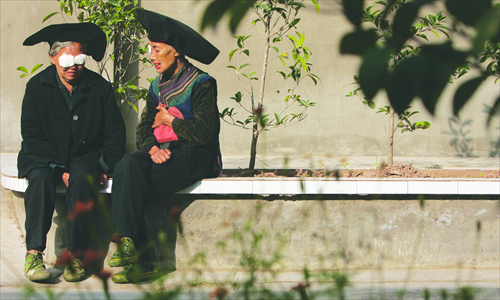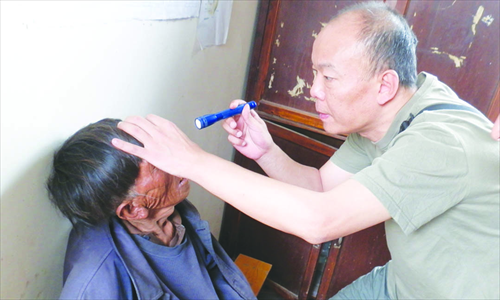HOME >> CHINA
Doctors without barriers
By Huang Jingjing Source:Global Times Published: 2014-7-4 5:03:01
Medical worker tries to bust stigma surrounding leprosy sufferers

Leprosy patients chat after receiving treatment. Photo: Courtesy of the Leprosy Project
Among the first batch of medical college graduates summoned by a national initiative in the late 1980s to help eliminate leprosy, Tang Xin, 52, an ophthalmologist in Guangzhou, Guangdong Province, has since devoted his life to the cause.Leprosy is a chronic infection caused by bacteria that can seriously damage the nervous system, skin and flesh. Before the 1980s, patients were sent into remote mountain regions as part of a government strategy to isolate the disease through natural barriers.
In the last three decades, Tang has done more than 10,000 operations of leprosy sufferers, including 4,000 on cataracts.
While he is happy to see a huge drop in the number of new leprosy cases and that leper villages have received lots of assistance from NGOs, social activists and the government, progress in eliminating the stigma surrounding the disease is still far from satisfactory.
Some hospitals still invariably reject leprosy sufferers. A few hospitals accepted patients but afterwords burned all the clothes and equipment used for the operation. "In one case back in 2005, a cataract patient was pulled down from the operation table after his identity as a former leper was known," Tang recalled. The patient later even attempted suicide. After learning about the case, Tang, leading his medical team, went to the patient's home and did an operation.
"Even today, my relatives tell others I'm an ophthalmologist instead of an ophthalmologist for leprosy sufferers, so as to avoid any problems," Tang said to the Global Times.

Tang Xin checks the eyes of a leprosy sufferer in Puge county, Sichuan Province, in May 2013. Photo: Courtesy of Tang Xin
Unlikely figureWearing a T-shirt, grey shorts and slippers, Tang hardly looks the part of a surgeon until he was introduced by local charity workers in Xichang, Liangshan Yi Autonomous Prefecture in Sichuan Province.
On June 16, after a six-hour drive from the city of Xichang followed by a five-hour trek, a medical team of three led by Tang arrived at Abuluoha village, Butuo county, Sichuan.
It is the second time he has been to the village, which formed in 1963 and is home to 40 leprosy sufferers and 160 of their descendants who are free of the disease. Thanks to the introduction of multi-drug therapy in the early 1980s, the patients have been completely cured, but still suffer from sequela: lost digits, and deformed eyes and limbs.
Of the more than 200 leper villages he has been to, Abuluoha, surrounded by steep mountains, left the deepest impression. The memory of his first visit is still fresh in his mind.
"We took 11 hours to get to the village, carrying heavy surgical instruments and a disassembled electric generator, climbing uphill and crossing rivers by rope bridges," he said.
The trek this time round is much easier. A new road connects the village to the outside world, and the introduction of electricity early this year means there is no need to bring along a generator.
With donations raised by an American lady from overseas, Tang works as an independent medical worker for leprosy sufferers. Occasionally, he is called on by domestic NGOs.
"It's truly hard to find a doctor who is willing go deep into the mountains to do surgeries, especially for leprosy sufferers," said Xu Xianfeng, director of the Leprosy Project, an NGO based in Xichang funded from Hong Kong since 2005. Xu's organization has paid Tang to carry out scores of surgeries in Liangshan.
In 1987, the 25-year-old Tang graduated from Hunan Medical College in Changsha, now the Xiangya School of Medicine, Central South University. A favored college graduate at a time when graduates were rare and their jobs guaranteed, he had the chance to work at major hospitals in Hunan.
Despite his parents' opposition, he chose to join the China Research Center for Leprosy Prevention and Treatment, established in 1985 in Guangdong under Ma Haide, or George Hatem, the first foreigner to be granted Chinese citizenship in 1949. At that time, Ma was an advisor for the Chinese health ministry.
The center recruited 17 college graduates and pledged to become the largest anti-leprosy center in Asia.
"Frankly speaking, my choice was not made out of great motives. Most of us, including myself, were lured by the promise of being sent to foreign countries like the US for further study and training," Tang said. At that time, going abroad was the holy grail among young people in China.
However, the center canceled these plans after 1989.
Being needed
Knowing that the disease carried very low risks of infection, Tang was surprised by the stigma against the patients, as well as the attitude of the doctors.
"The air was heavy for medical workers entering leprosy villages. They wore protective clothes, masks, gloves, boots, with only their eyes exposed, and used tongs to give things to the patients," he said.
To set an example, Tang and his colleagues were asked not to wear any protective clothes and observe patients' injuries directly.
They were well received among leprosy villages, but despised in the outside world. They met difficulties in finding spouses, and even their medical colleagues shunned them.
Within 10 years, the other 16 college graduates had either been sent overseas for study and training, or took other jobs, leaving Tang alone in leprosy-related medicine.
In 1997, he finally got married to a charity worker involved in rehabilitation and welfare for leprosy patients.
In 2002, the center was disbanded and Tang joined a leprosy NGO in Guangdong, which he left four years later. "I thought of establishing an organization but gave up as I found that after the high maintenance fees, there were very few funds left for those in need," he said.
Now affiliated with the China Leprosy Association as its deputy secretary-general, he works as a freelance surgeon for leprosy sufferers. "When there's money being raised, I set off," he said.
He had worked as a highly paid medical representative, but returned to the leprosy cause after a few months. "After engaging in work with leprosy patients for so many years, I've already become used to the working conditions. What's more, it gives me a strong sense of accomplishment," he said.
Tang Xin has become a household name among leprosy villagers, who always receive him as a distinguished guest. And he feels they need doctors like him.
Newspaper headline: Medical worker tries to bust stigma surrounding leprosy sufferers
Posted in: Profile, In-Depth